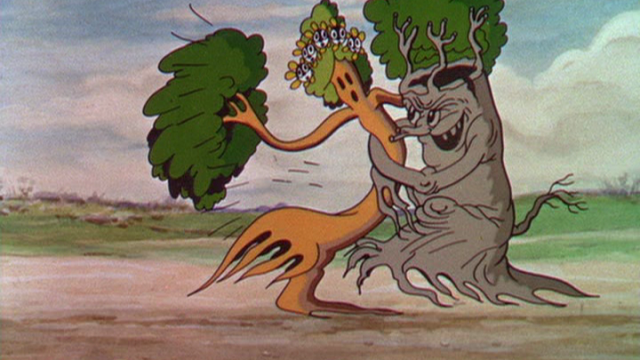For a while now, I’ve been noticing this one as available on Disney+ and thinking, “Wow, I should really write about that at some point.” And then, actually I’d already told someone I’d write about something else, it was announced this week that it was being added to the National Film Registry, and . . . I’m sorry. We’ll probably talk about the weird place of Figaro the Cat in Disney shorts next week, folks. For now, let’s talk about something possibly even stranger.
Your standard idyllic Disney nature setting. Birds, bugs, eponymous flowers and trees. All living in some sort of pleasant harmony. A young tree is courting a . . . I guess beautiful female tree? Anyway, he makes a harp out of another tree and some vines, and he plays for her, and she powders herself with pollen, and things are going quite nicely until a craggled old hollow tree sees her and wants her for himself. She’s not interested. To get revenge, he starts a fire. Predictable consequences follow.
I’d long known that this was the first colour Disney cartoon, but that’s just the start to its, and we might as well quote here, “cultural, historical, or aesthetic significance.” Because this is the first three-strip Technicolor film ever made. Herbert Kalmus, the jovial-looking man who invented the process, wanted an animator to test the process, since that made more technical sense in a lot of ways. The only animator who took him up on it was Walt, which is not surprising. Walt was quite fond of new technology, after all.
In fact, they’d started the cartoon in B&W, scrapped it, and started over in Technicolor, which inflated its budget enormously. However, its popularity was so enormous that it made more than enough profit to make up for going over budget. From that point on, Walt stopped making B&W, and let’s be real—this was one of the important steps on the road to Snow White. What’s interesting to me is that, unlike early live action Technicolor like The Adventures of Robin Hood, this short doesn’t feel as obligated to use approximately All The Colours and works in a relatively restrained pallet. Presumably, this is much more due to paint limitations.
Fine, but what about the actual subject matter? Well, it’s weird. For one thing, that old hollow tree has a belly button, and how does that even work? At one point, the young tree (no, none of these characters have been given names, even in later Disney lore) is possibly dueling with the old one, but can we be sure? It’s a big stick versus a thinner stick, and is that a club against a sword? Two swords? Two clubs? Who can even tell? And then he uses the thinner stick to tickle the old tree, and I don’t even know where to begin.
At one point, the young tree jumps out of his lower bark and into different lower bark in a stream or pond or something. It’s a decent enough gag, but it’s another one of those things that’s weird and I don’t fully understand it. A centipede disassembling is just standard cartoon nature, and the sentient flames ditto, but still. Every once in a while, the cartoon has a moment that makes you uncertain if you really saw what you thought you did.
It is beautiful, though, in that early ’30s way. There is a very clear style of drawing that appears a lot across studios, and this definitely uses that style—any time cartoons are trying to be pretty instead of wacky, there’s a sameness, and we’re in the middle of that. That’s fine; it works because it is pretty, and while I am not the Artdork around here, I do know enough to pick up on similarities to other art at the time. It’s also interesting that trees on the backgrounds of certain scenes are shown to be reacting to the action—not all the trees are shown as sentient, which is another weirdness, but not all the sentient ones are individually cel-drawn.
This is a fine choice for the National Film Registry. I’m not just saying this as a Disney fan. They’re trying to include films that have all kinds of historical value, and I’m pretty sure “first three-strip Technicolor film” counts in that. It’s not the best Disney short, goodness knows, but it’s one of the most significant. I was going to get around to it at some point, and the Library of Congress suggested that now was the time.
I don’t need the budget to restore a classic animated short, but I’d still appreciate it if you’d support my Patreon or Ko-fi!

